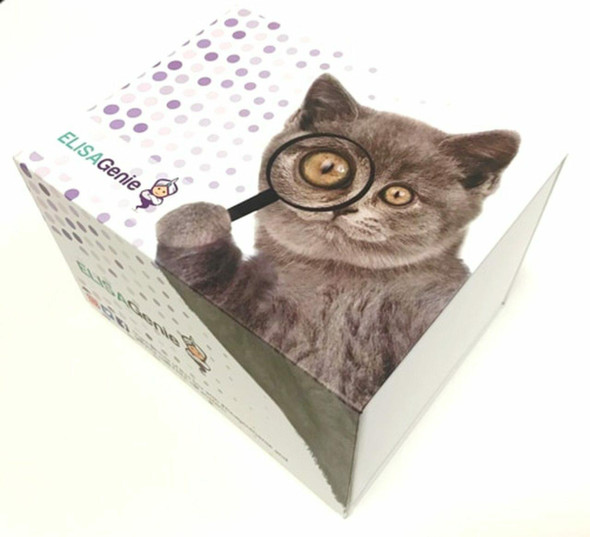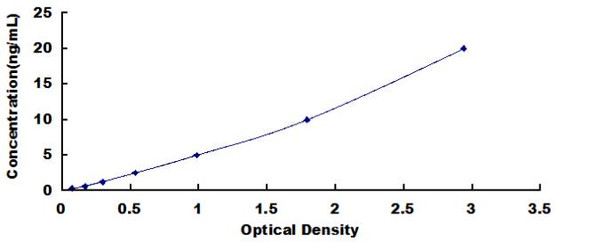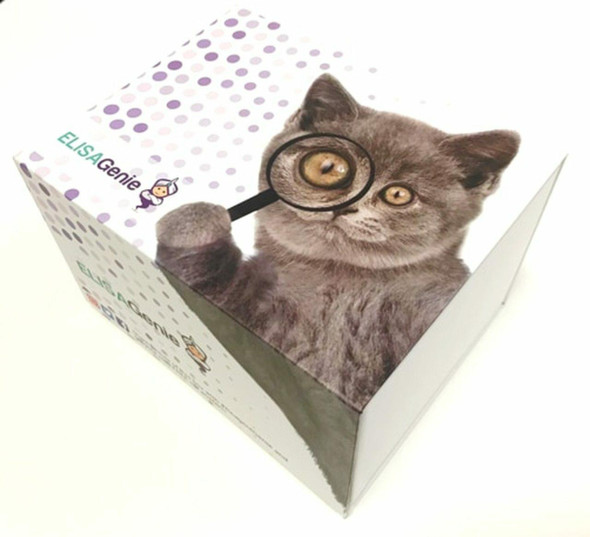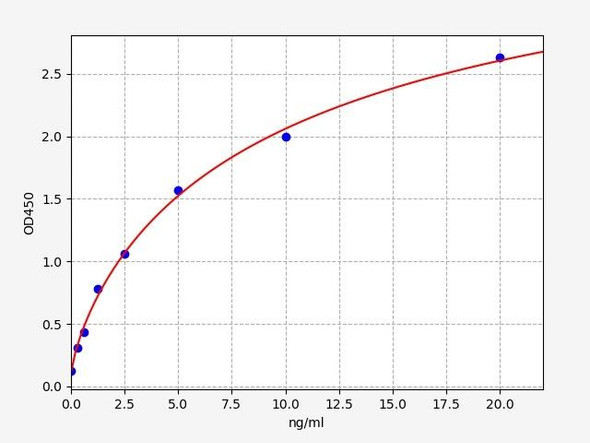Description
Human Calcium and integrin-binding protein 1 (CIB1) ELISA Kit
The Human Calcium and Integrin Binding Protein 1 (CIB1) ELISA Kit is specifically designed for the precise measurement of CIB1 levels in human serum, plasma, and cell culture supernatants. This innovative kit offers unparalleled sensitivity and specificity, ensuring accurate and consistent results, making it a valuable tool for a variety of research applications.CIB1 is a key protein involved in calcium signaling and integrin-mediated cell adhesion, playing a critical role in cellular processes such as cell migration, proliferation, and differentiation. Dysregulation of CIB1 has been implicated in various diseases, including cancer, cardiovascular disorders, and immune system dysfunction, highlighting its importance as a potential biomarker for disease progression and therapeutic development.
With the Human CIB1 ELISA Kit, researchers can confidently study the role of CIB1 in disease pathology and explore novel therapeutic strategies targeting this protein. Trust in the reliability and accuracy of this kit to advance your research and uncover new insights into the functions of CIB1 in human health and disease.
| Product Name: | Human Calcium and integrin-binding protein 1 (CIB1) ELISA Kit |
| SKU: | HUEB1466 |
| Size: | 96T |
| Target: | Human Calcium and integrin-binding protein 1 (CIB1) |
| Synonyms: | Calcium- and integrin-binding protein, Calmyrin, DNA-PKcs-interacting protein, Kinase-interacting protein, SNK-interacting protein 2-28, CIBP, KIP, SIP2-28, CIB, CIB, KIP, PRKDCIP |
| Assay Type: | Sandwich |
| Detection Method: | ELISA |
| Reactivity: | Human |
| Detection Range: | 0.312-20ng/mL |
| Sensitivity: | 0.174ng/mL |
| Intra CV: | 7.5% | ||||||||||||||||||||
| Inter CV: | 9.7% | ||||||||||||||||||||
| Linearity: |
| ||||||||||||||||||||
| Recovery: |
| ||||||||||||||||||||
| Function: | Isoform 2: Plays a regulatory role in angiogenesis and tumor growth by mediating PKD/PRKD2-induced vascular endothelial growth factor A (VEGFA) secretion. |
| Uniprot: | Q99828 |
| Sample Type: | Serum, plasma, tissue homogenates, cell culture supernates and other biological fluids |
| Specificity: | Natural and recombinant human Calcium and integrin-binding protein 1 |
| Sub Unit: | Monomer. Interacts with MYO1C. Interacts (via C-terminal region) with PPP3R1 and CACNA1C; the interactions increase upon cardiomyocytes hypertrophy (By similarity). Interacts with the heterodimeric integrin alpha-IIb/beta3 (ITGA2B-ITGB3). Interacts with ITGA2B (via cytoplasmic domain); the interaction is direct and calcium-dependent. Interacts with the protein kinases PLK2/SNK and PRKDC (via the region immediately upstream of the kinase domain). Interacts with PLK3; the interaction inhibits PLK3 kinase activity. Interacts with PSEN2. Interacts (via C-terminus) with F8. Interacts with NBR1 (via C-terminus). Interacts with FEZ1 (via C-terminus). Interacts with UBR5 (via C-terminus); the interaction is sensitive to DNA damage, and may target CIB1 for ubiquitin-mediated degradation. Interacts with IFI6. Interacts with BCL2. Interacts with ITPR3; the interaction occurs in a calcium-dependent manner. Interacts with PTK2/FAK1. Interacts with MAP3K5; the interaction inhibits MAP3K5 activation by phosphorylation, and its subsequent interaction with TRAF2. Isoform 2 interacts with PRKD2 (via N-terminal AP-rich region), PTK2/FAK1 and PAK1. Interacts with TAS1R2 (via C-terminus); the interaction is independent of the myristoylation state of CIB1. Interacts (via C-terminal region) with STMN2 (via the N-terminal region); the interaction is direct, occurs in a calcium-dependent manner and attenuates the STMN2-induced neurite outgrowth inhibition. Interacts with SPHK1, the interaction occurs in a calcium-dependent manner. Interacts with ITGA2B (via C-terminal cytoplasmic tail); the interaction occurs upon platelet aggregation and is stabilized/increased in a calcium and magnesium-dependent manner. Interacts with PAK1 (via N-terminal region); the interaction is direct and occurs in a calcium-dependent manner. Interacts with RAC3 (via C-terminal region); the interaction induces their association with the cytoskeleton upon alpha-IIb/beta3 integrin-mediated adhesion. Interacts with ITGA5 and ITGAV. |
| Research Area: | Cardiovascular |
| Subcellular Location: | Isoform 2 Cytoplasm Perinuclear region Golgi apparatus Trans-Golgi network |
| Storage: | Please see kit components below for exact storage details |
| Note: | For research use only |
| UniProt Protein Function: | CIB1: May convert the inactive conformation of integrin alpha- IIb/beta3 to an active form through binding to the integrin cytoplasmic domain. Induces cell migration and spreading mediated through integrin (possibly via focal adhesion complexes). Functions as a negative regulator of stress activated MAP kinase (MAPK) signaling pathways. May play a role in regulation of apoptosis. Interacts with and up-regulates PTK2/FAK1 activity. Down regulates inositol 1,4,5-trisphosphate receptor-dependent calcium signaling. Participates in endomitotic cell cycle, a form of mitosis in which both karyokinesis and cytokinesis are interrupted and is a hallmark of megakaryocyte differentiation. |
| UniProt Protein Details: | Protein type:Cell adhesion; Motility/polarity/chemotaxis Chromosomal Location of Human Ortholog: 15q25.3-q26 Cellular Component: Golgi apparatus; filopodium tip; centrosome; neuron projection; endoplasmic reticulum; nucleoplasm; growth cone; membrane; cell soma; perinuclear region of cytoplasm; lamellipodium; apical plasma membrane; cytoplasm; plasma membrane; nucleus; vesicle; sarcolemma Molecular Function:protein binding; Ras GTPase binding; protein anchor; calcium ion binding Biological Process: apoptosis; endomitotic cell cycle; negative regulation of megakaryocyte differentiation; cytoplasmic microtubule organization and biogenesis; activation of NF-kappaB transcription factor; negative regulation of cell proliferation; negative regulation of protein amino acid phosphorylation; double-strand break repair; positive regulation of cell proliferation; angiogenesis; positive regulation of cell-matrix adhesion; cell adhesion; negative regulation of protein kinase B signaling cascade; negative regulation of microtubule depolymerization; positive regulation of cell adhesion mediated by integrin; positive regulation of metalloenzyme activity; positive regulation of cell growth; regulation of cell proliferation; cell division; positive regulation of protein amino acid phosphorylation; platelet formation; response to DNA damage stimulus; regulation of cell division; spermatid development; negative regulation of apoptosis; positive regulation of cell migration |
| NCBI Summary: | This gene encodes a member of the EF-hand domain-containing calcium-binding superfamily. The encoded protein interacts with many other proteins, including the platelet integrin alpha-IIb-beta-3, DNA-dependent protein kinase, presenilin-2, focal adhesion kinase, p21 activated kinase, and protein kinase D. The encoded protein may be involved in cell survival and proliferation, and is associated with several disease states including cancer and Alzheimer's disease. Alternative splicing results in multiple transcript variants. [provided by RefSeq, Apr 2013] |
| UniProt Code: | Q99828 |
| NCBI GenInfo Identifier: | 134047806 |
| NCBI Gene ID: | 10519 |
| NCBI Accession: | Q99828.4 |
| UniProt Secondary Accession: | Q99828,O00693, O00735, Q6IB49, Q96J54, Q99971, B5BU40 H6WJF3, |
| UniProt Related Accession: | Q99828 |
| Molecular Weight: | 26,032 Da |
| NCBI Full Name: | Calcium and integrin-binding protein 1 |
| NCBI Synonym Full Names: | calcium and integrin binding 1 (calmyrin) |
| NCBI Official Symbol: | CIB1 |
| NCBI Official Synonym Symbols: | CIB; CIBP; KIP1; PRKDCIP; SIP2-28 |
| NCBI Protein Information: | calcium and integrin-binding protein 1; DNA-PK interaction protein; DNA-PKcs-interacting protein; SNK-interacting protein 2-28; DNA-dependent protein kinase interacting protein |
| UniProt Protein Name: | Calcium and integrin-binding protein 1 |
| UniProt Synonym Protein Names: | Calcium- and integrin-binding protein; CIBP; Calmyrin; DNA-PKcs-interacting protein; Kinase-interacting protein; KIP; SNK-interacting protein 2-28; SIP2-28 |
| Protein Family: | Calcium and integrin-binding protein |
| UniProt Gene Name: | CIB1 |
| UniProt Entry Name: | CIB1_HUMAN |
| Component | Quantity (96 Assays) | Storage |
| ELISA Microplate (Dismountable) | 8×12 strips | -20°C |
| Lyophilized Standard | 2 | -20°C |
| Sample Diluent | 20ml | -20°C |
| Assay Diluent A | 10mL | -20°C |
| Assay Diluent B | 10mL | -20°C |
| Detection Reagent A | 120µL | -20°C |
| Detection Reagent B | 120µL | -20°C |
| Wash Buffer | 30mL | 4°C |
| Substrate | 10mL | 4°C |
| Stop Solution | 10mL | 4°C |
| Plate Sealer | 5 | - |
Other materials and equipment required:
- Microplate reader with 450 nm wavelength filter
- Multichannel Pipette, Pipette, microcentrifuge tubes and disposable pipette tips
- Incubator
- Deionized or distilled water
- Absorbent paper
- Buffer resevoir
*Note: The below protocol is a sample protocol. Protocols are specific to each batch/lot. For the correct instructions please follow the protocol included in your kit.
Allow all reagents to reach room temperature (Please do not dissolve the reagents at 37°C directly). All the reagents should be mixed thoroughly by gently swirling before pipetting. Avoid foaming. Keep appropriate numbers of strips for 1 experiment and remove extra strips from microtiter plate. Removed strips should be resealed and stored at -20°C until the kits expiry date. Prepare all reagents, working standards and samples as directed in the previous sections. Please predict the concentration before assaying. If values for these are not within the range of the standard curve, users must determine the optimal sample dilutions for their experiments. We recommend running all samples in duplicate.
| Step | |
| 1. | Add Sample: Add 100µL of Standard, Blank, or Sample per well. The blank well is added with Sample diluent. Solutions are added to the bottom of micro ELISA plate well, avoid inside wall touching and foaming as possible. Mix it gently. Cover the plate with sealer we provided. Incubate for 120 minutes at 37°C. |
| 2. | Remove the liquid from each well, don't wash. Add 100µL of Detection Reagent A working solution to each well. Cover with the Plate sealer. Gently tap the plate to ensure thorough mixing. Incubate for 1 hour at 37°C. Note: if Detection Reagent A appears cloudy warm to room temperature until solution is uniform. |
| 3. | Aspirate each well and wash, repeating the process three times. Wash by filling each well with Wash Buffer (approximately 400µL) (a squirt bottle, multi-channel pipette,manifold dispenser or automated washer are needed). Complete removal of liquid at each step is essential. After the last wash, completely remove remaining Wash Buffer by aspirating or decanting. Invert the plate and pat it against thick clean absorbent paper. |
| 4. | Add 100µL of Detection Reagent B working solution to each well. Cover with the Plate sealer. Incubate for 60 minutes at 37°C. |
| 5. | Repeat the wash process for five times as conducted in step 3. |
| 6. | Add 90µL of Substrate Solution to each well. Cover with a new Plate sealer and incubate for 10-20 minutes at 37°C. Protect the plate from light. The reaction time can be shortened or extended according to the actual color change, but this should not exceed more than 30 minutes. When apparent gradient appears in standard wells, user should terminatethe reaction. |
| 7. | Add 50µL of Stop Solution to each well. If color change does not appear uniform, gently tap the plate to ensure thorough mixing. |
| 8. | Determine the optical density (OD value) of each well at once, using a micro-plate reader set to 450 nm. User should open the micro-plate reader in advance, preheat the instrument, and set the testing parameters. |
| 9. | After experiment, store all reagents according to the specified storage temperature respectively until their expiry. |
When carrying out an ELISA assay it is important to prepare your samples in order to achieve the best possible results. Below we have a list of procedures for the preparation of samples for different sample types.
| Sample Type | Protocol |
| Serum | If using serum separator tubes, allow samples to clot for 30 minutes at room temperature. Centrifuge for 10 minutes at 1,000x g. Collect the serum fraction and assay promptly or aliquot and store the samples at -80°C. Avoid multiple freeze-thaw cycles. If serum separator tubes are not being used, allow samples to clot overnight at 2-8°C. Centrifuge for 10 minutes at 1,000x g. Remove serum and assay promptly or aliquot and store the samples at -80°C. Avoid multiple freeze-thaw cycles. |
| Plasma | Collect plasma using EDTA or heparin as an anticoagulant. Centrifuge samples at 4°C for 15 mins at 1000 × g within 30 mins of collection. Collect the plasma fraction and assay promptly or aliquot and store the samples at -80°C. Avoid multiple freeze-thaw cycles. Note: Over haemolysed samples are not suitable for use with this kit. |
| Urine & Cerebrospinal Fluid | Collect the urine (mid-stream) in a sterile container, centrifuge for 20 mins at 2000-3000 rpm. Remove supernatant and assay immediately. If any precipitation is detected, repeat the centrifugation step. A similar protocol can be used for cerebrospinal fluid. |
| Cell culture supernatant | Collect the cell culture media by pipette, followed by centrifugation at 4°C for 20 mins at 1500 rpm. Collect the clear supernatant and assay immediately. |
| Cell lysates | Solubilize cells in lysis buffer and allow to sit on ice for 30 minutes. Centrifuge tubes at 14,000 x g for 5 minutes to remove insoluble material. Aliquot the supernatant into a new tube and discard the remaining whole cell extract. Quantify total protein concentration using a total protein assay. Assay immediately or aliquot and store at ≤ -20 °C. |
| Tissue homogenates | The preparation of tissue homogenates will vary depending upon tissue type. Rinse tissue with 1X PBS to remove excess blood & homogenize in 20ml of 1X PBS (including protease inhibitors) and store overnight at ≤ -20°C. Two freeze-thaw cycles are required to break the cell membranes. To further disrupt the cell membranes you can sonicate the samples. Centrifuge homogenates for 5 mins at 5000xg. Remove the supernatant and assay immediately or aliquot and store at -20°C or -80°C. |
| Tissue lysates | Rinse tissue with PBS, cut into 1-2 mm pieces, and homogenize with a tissue homogenizer in PBS. Add an equal volume of RIPA buffer containing protease inhibitors and lyse tissues at room temperature for 30 minutes with gentle agitation. Centrifuge to remove debris. Quantify total protein concentration using a total protein assay. Assay immediately or aliquot and store at ≤ -20 °C. |
| Breast Milk | Collect milk samples and centrifuge at 10,000 x g for 60 min at 4°C. Aliquot the supernatant and assay. For long term use, store samples at -80°C. Minimize freeze/thaw cycles. |











